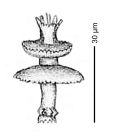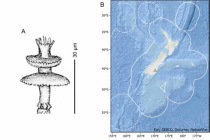
| Intro | | About | | Wiki | | Search traits | | Data explorer | | Literature | | Definitions | | Sources | | Webservices | | Statistics | | Feedback | | Editors | | Log in |
Porifera taxon detailsLatrunculia (Latrunculia) tutu Kelly & Sim-Smith, 2022 †
1613673 (urn:lsid:marinespecies.org:taxname:1613673)
accepted
Species
marine,
fossil only
Sim-Smith, C.; Janussen, D.; Ríos, P.; Macpherson, D.; Kelly, M. (2022). The Marine Biota of New Zealand: A review of New Zealand and Antarctic latrunculid sponges with new taxa and new systematic arrangements within family Latrunculiidae (Demospongiae, Poecilosclerida). <em>NIWA Biodiversity Memoir.</em> 134: 1-144.
page(s): 73-74 [details] Available for editors
Note Type location and age. Hinde & Holmes (1892)...
From regional or thematic species database
Type locality Type location and age. Hinde & Holmes (1892) did not specify the exact location of the microfossil spicule collection, other than it came from three possible locations in the Oamaru District (Fig. 42B): Cormacks Siding, Jackson’s Paddock and Bain’s Farm (Lautour 1889; Edwards 1991) (see Kelly et al. 2016). The microfossil anisodiscorhabds are from marine diatomaceous sediments of the Oamaru Diatomite member of the basaltic Waiareka Volcanic Formation (Hinde & Holmes 1892). Runangan (Late Eocene) age (36.4–34.6 Ma) (Edwards 1991). The dagger symbol (†) following the species name indicates that this is a fossil species (from Kelly et al. 2016). [details]
Type material Material examined. None. [details]
Description Spicules (Fig. 42). Microscleres are microfossil anisodiscorhabds with a stout, ‘subcylindrical’ shaft, with two whorls...
Description Spicules (Fig. 42). Microscleres are microfossil anisodiscorhabds with a stout, ‘subcylindrical’ shaft, with two whorls of small spines at the base, the manubrium spines appearing to form an inverted crown, while the basal whorl appears to be eroded but forms a ring of spines projecting horizontally. Above the base of the anisodiscorhabd is an ‘inverted saucer-like disc with dentated margin’, the median whorl, succeeded by a ‘similar but smaller disc with concavity upwards’, the subsidiary whorl. At the summit is an apical whorl of curved teeth or spines that appear to splay obliquely in the shape of a crown, but an apical tuft or spine is absent. The overall length of the anisodiscorhabd is 43 μm, the width of the lower, widest disc is 27 μm, and the thickness of the shaft [details] Etymology Named for the form of the median whorl which resembles a ballerina’s tutu.
Etymology Named for the form of the median whorl which resembles a ballerina’s tutu. [details]
de Voogd, N.J.; Alvarez, B.; Boury-Esnault, N.; Cárdenas, P.; Díaz, M.-C.; Dohrmann, M.; Downey, R.; Goodwin, C.; Hajdu, E.; Hooper, J.N.A.; Kelly, M.; Klautau, M.; Lim, S.C.; Manconi, R.; Morrow, C.; Pinheiro, U.; Pisera, A.B.; Ríos, P.; Rützler, K.; Schönberg, C.; Turner, T.; Vacelet, J.; van Soest, R.W.M.; Xavier, J. (2024). World Porifera Database. Latrunculia (Latrunculia) tutu Kelly & Sim-Smith, 2022 †. Accessed at: https://marinespecies.org/porifera/porifera.php/porifera.php?p=taxdetails&id=1613673 on 2024-08-06
Date action by
original description
Sim-Smith, C.; Janussen, D.; Ríos, P.; Macpherson, D.; Kelly, M. (2022). The Marine Biota of New Zealand: A review of New Zealand and Antarctic latrunculid sponges with new taxa and new systematic arrangements within family Latrunculiidae (Demospongiae, Poecilosclerida). <em>NIWA Biodiversity Memoir.</em> 134: 1-144.
page(s): 73-74 [details] Available for editors  Present Present  Inaccurate Inaccurate  Introduced: alien Introduced: alien  Containing type locality Containing type locality
From regional or thematic species database
Description Spicules (Fig. 42). Microscleres are microfossil anisodiscorhabds with a stout, ‘subcylindrical’ shaft, with two whorls of small spines at the base, the manubrium spines appearing to form an inverted crown, while the basal whorl appears to be eroded but forms a ring of spines projecting horizontally. Above the base of the anisodiscorhabd is an ‘inverted saucer-like disc with dentated margin’, the median whorl, succeeded by a ‘similar but smaller disc with concavity upwards’, the subsidiary whorl. At the summit is an apical whorl of curved teeth or spines that appear to splay obliquely in the shape of a crown, but an apical tuft or spine is absent. The overall length of the anisodiscorhabd is 43 μm, the width of the lower, widest disc is 27 μm, and the thickness of the shaft [details]Etymology Named for the form of the median whorl which resembles a ballerina’s tutu. [details] Holotype Type & locality (not examined). Holotype microfossil anisodiscorhabds illustrated as Latrunculia (m) by Hinde & Holmes (1892: 219; pl. 11 Fig. 38), Taylor’s Quarry, Oamaru, New Zealand. [details] Remark The morphology of the microfossil anisodiscorhabd of Late Eocene L. (L.) tutu sp. nov. strongly resembles that of the extant species, L. (L.) incristata sp. nov. Both anisodiscorhabds are highly distinctive with smooth, finely crenulate, disc-shaped whorls, and both lack an apical tuft or spine. The major differences between the two species are that, in L. (L.) tutu sp. nov., the apical whorl is a whorl of everted spines that form a crown, but in L. (L.) incristata sp. nov., the apical whorl forms a solid inverted cone with denticulate margins. The microfossil anisodiscorhabd of L. (L.) tutu sp. nov. (43 × 27 μm) is also much smaller than that of L. (L.) incristata sp. nov. (61 × 35 μm). Finally, the two species have a disjunct distribution: L. (L.) tutu sp. nov. was collected from the Oamaru district in the South Island, whereas L. (L.) incristata sp. nov. was collected from the Norfolk Ridge to the northwest of New Zealand. [details] Type locality Type location and age. Hinde & Holmes (1892) did not specify the exact location of the microfossil spicule collection, other than it came from three possible locations in the Oamaru District (Fig. 42B): Cormacks Siding, Jackson’s Paddock and Bain’s Farm (Lautour 1889; Edwards 1991) (see Kelly et al. 2016). The microfossil anisodiscorhabds are from marine diatomaceous sediments of the Oamaru Diatomite member of the basaltic Waiareka Volcanic Formation (Hinde & Holmes 1892). Runangan (Late Eocene) age (36.4–34.6 Ma) (Edwards 1991). The dagger symbol (†) following the species name indicates that this is a fossil species (from Kelly et al. 2016). [details] Type material Material examined. None. [details] |


